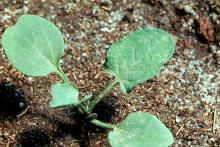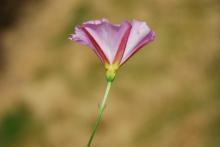2,4-D (for suppression) amine
Rate Broadcast treatment: 2 to 3 lb ae/A
Time Apply at bud growth stage or at summer fallow in early August.
Remarks Use 2,4-D to help reduce bindweed stand 60 to 80% and prevent seedling establishment. It is important to apply 2,4-D every year; skipping an application gives bindweed a chance to recover. During the grain year, apply 2,4-D to growing winter wheat. After wheat matures, apply 2,4-D with a sprayer mounted on the combine, or apply after combining.
Caution Avoid drift to sensitive crops.
Site of action Group 4: synthetic auxin
Chemical family Phenoxy acetic acid
aminocyclopyrachlor + chlorsulfuron (Perspective)
Rate 1.8 to 3.2 oz/A aminocyclopyrachlor + 0.7 to 1.3 oz/A chlorsulfuron (4.5 to 8 oz/A of product)
Time Apply to broadleaf weeds in spring.
Remarks Adjuvants can be used, these include methylated seed oils 0.5 to 1% v/v, nonionic surfactants at 0.25 to 1% v/v, and crop oil concentrates at 1% v/v. Can be applied using an invert emulsion rather than water.
Caution Even low rates can kill nontarget tree and shrub species, so avoid application within a distance equal to the tree height of the sensitive species. Do not allow spray to drift off target. Can injure several grass species including bromes, as well as basin wildrye.
Site of action (aminocyclopyrachlor) Group 4: Synthetic auxin; (chlorsulfuron) Group 2: ALS inhibitor
Chemical family (aminocyclopyrachlor) Pyrimidine carboxylic acid; (chlorsulfuron) Sulfonylurea
dicamba (Rifle or Clarity) or dicamba + 2,4-D (for suppression)
Rate 0.5 to 1 lb ae/A dicamba; or 0.5 to 1 lb ae/A dicamba + 1 to 2 lb ae/A 2,4-D
Time Apply during fallow, before planting and when weeds are actively growing.
Remarks Rates are to suppress field bindweed.
Caution Refer to label for crop rotation restrictions. Avoid drift to sensitive crops.
Site of action (both) Group 4: synthetic auxin
Chemical family (dicamba) benzoic acid; (2,4-D) phenoxy acetic acid
dicamba (Rifle or Clarity) or dicamba + 2,4-D (for control)
Rate 1 to 2 lb ae/A dicamba; or 1 to 2 lb ae/A dicamba + 1 to 2 lb ae/A 2,4-D
Time Apply in late summer or fall before killing frost.
Remarks Control is best when weeds are actively growing and in postbloom stage. Make follow-up application in spring to control seedlings.
Caution See label for in-crop use and rotation restrictions. Avoid drift to sensitive crops.
Site of action (both) Group 4: synthetic auxin
Chemical family (dicamba) benzoic acid; (2,4-D) phenoxy acetic acid
glyphosate
Rate 3 to 3.75 lb ae/A
Time Apply at full bloom to early seed stage of maturity. Application on fall regrowth may provide some control.
Remarks Cover foliage thoroughly but avoid spray runoff. Re-treatments may be needed for complete control. Control improves if the treated area is tilled 2 to 3 weeks after treatment.
Caution Glyphosate controls grasses as well as other vegetation in treated areas.
Site of action Group 9: inhibits EPSP synthase
Chemical family None generally accepted
glyphosate + 2,4-D (Landmaster BW)
Rate 0.378 to 0.67 lb ae/A (54 oz/A Landmaster)
Time Apply in fallow or postharvest to bindweed runners at least 10 inches long. Use 1% solution to spot treat with high-volume, spray-to-wet applications. Tilling after treatment may improve control.
Remarks In fallow, cultivate until July 1; then allow weeds to grow to treatment stage.
Caution Avoid drift to sensitive crops.
Site of action (glyphosate) Group 9: inhibits EPSP synthase; (2,4-D) Group 4: synthetic auxin
Chemical family (glyphosate) none generally accepted; (2,4-D) phenoxy acetic acid
glyphosate + dicamba (Rifle or Clarity)
Rate 1.5 lb ae/A glyphosate + 0.5 lb ae/A dicamba
Time Apply mid- to late-bloom but before seed matures. Applying to fall regrowth may give some control.
Remarks Use this tank-mix during summer fallow before planting small grains.
Caution Crop may be somewhat injured if dicamba is applied within 45 days of planting. Glyphosate controls grasses as well as other vegetation in treated areas.
Site of action (glyphosate) Group 9: inhibits EPSP synthase; (2,4-D) Group 4: synthetic auxin
Chemical family (glyphosate) none generally accepted; (dicamba) benzoic acid
imazapic (Plateau)
Rate 0.125 to 0.188 lb ai/A
Time Apply after 25% bloom through fall to actively growing bindweed.
Remarks Add 1 quart/A methylated seed oil.
Caution Note crop rotation restrictions before using.
Site of action Group 2: acetolactate synthase (ALS) inhibitor
Chemical family Imidazolinone
metsulfuron (Escort)
Rate 0.6 to 1.2 oz ai/A (1 to 2 oz/A)
Time Apply to actively growing bindweed in bloom stage.
Remarks Treatment is suppressive. Use a nonionic or silicone surfactant to improve control.
Caution Do not allow spray drift to sensitive crops. This rate is only for non-crop sites.
Site of action Group 2: acetolactate synthase (ALS) inhibitor
Chemical family Sulfonylurea
picloram (Tordon)
Rate 1 lb ae/A
Time Apply in the growing season on non-cropland when bindweed is visible. Timing is not critical, but results are most consistent if bindweed is in early bud to full bloom.
Remarks Apply as a coarse, low-pressure spray in sufficient volume to cover adequately. For control in fallow, refer to Winter Wheat-Nonirrigated East of the Cascades in this handbook.
Caution A restricted-use herbicide. Picloram is registered only on rangeland and permanent pastures and on fallow grainland east of the Cascades. Do not contaminate water. Potatoes, beans, and many other broadleaf crops are sensitive to picloram. Do not plant these crops until an adequately sensitive bioassay or chemical test shows that no picloram is detectable in the soil. Extend treatment 10 ft beyond the infestation. Do not use in diversified cropping areas.
Site of action Group 4: synthetic auxin
Chemical family Pyridine
quinclorac (Paramount)
Rate 6 oz ai/A (8 oz/A)
Time Apply in fall before frost to actively growing bindweed with stems at least 4 inches long.
Remarks Must add methylated seed oil at 1 to 2 pints/A or crop oil concentrate at 2 pints/A. Plant uptake is through foliage and roots. Rain after application is important for soil uptake.
Caution Note crop rotation restrictions before using. Do not exceed 12 oz ai/A per calendar year.
Site of action Group 4: synthetic auxin
Chemical family Quinoline carboxylic acid




